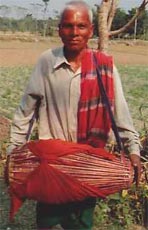KHOL
Introduction
The Khol is a double skin drum with a resonating body from northern and eastern India. Khol is usually used traditionally for accompanying Bhajans and Kirtans. Its high skin is relatively small with a diameter of about 9 - 10 cm, which gives it a particularly high, piercing sound and it is used where this kind of sound is desirable. In India the Khol is used in folk music, in spiritual songs, bhajans, light classical songs, Kirtans and other devotional songs.The bass skin has a diameter of approximately 20 cm and is coated on the outside with a special paste in order to get a low sound. Both skins have, like the Tabla, a double leather layer at the outer rim. They are tautened by a leather strap. The normal Tabla finger technique can usually be used. 108 different Taals are available for the Khol.
There is a close connection between the way of playing the Tabla and the way of playing the Khol. However there are special syllables for the Khol such as Ta, Deta, Dhoia, Jhan, Ghini, TiT, Tini, Naka, Guru, etc. Should the bass side have a too high tautness, the skin can be rubbed with a moist cotton cloth between Kinar and Gab.

Khol also called mridang, is a folk drum of northeast India. It has a body made of clay, a very small head on the right side (approximately 4 inches), and a larger head on the left side. A fiberglass version of the khol has become popular in the West among the members of ISKCON. It is very popular in the kirtans of Bengal, but it is also found throughout the northeast including Bangladesh.
For devotees of Lord Krishna, the khol is almost always the instrument everyone wants to learn. However, intentions and desires would define what extent the instrument should be taught to. If one wants to be able to accompany harinams or artis, then the lowest standard of learning is required. To be able to accompany a classical bhajan requiring clean and crisp sounds, then one must take it to the second standard of learning. If one wishes to go to classical music, then tabla should be studied first, before learning the khol. Tabla will teach the discipline of learning an instrument in addition to sounds that cannot be produced on the khol. The khol is the ultimate basic which can be taken to higher extents with tabla knowledge.
This is by far, the most popular drum in our movement. The khol, also known as mridanga, has a clay body with greater girth. The smaller head, the daya, has a head size of three inches in diameter, tuned to the "ma" or "pa", rarely "sa" of the raga. The bigger head, the baya, has a diameter around nine inches tuned to the low tonic. The overall sound of this drum is very high pitched than the typical tabla or pakhawaj. Both heads are made of goat skin with iron syahi. The khol is used in bhajan and kirtan, especially amongst the Gaudiya Vaishnavas and Bengali musicians.
The khol was introducted to ISKCON by Srila Prabhupada and ever since the temples started growing, the khols have diverged into four different styles. The first is having a fiberglass body with skin heads. The second style is using brass body with skin heads. The third style was invented by Isan Das, who invented a heavy fiberglass body with plastic heads with black rubber as the syahi. This is known as the "Balarama mridanga." Lastly, the khol with skin heads could be made from buffalo skins, and clay syahis. The Balarama mridanga and the buffalo skinned khols are now known for "banging" kirtans.
Where to buy a Khol
AccuVis DBA WorldMusicalInstruments.com931 W. 75th Street, Suite 137 - #128
Naperville, IL, USA, 60565
Phone: 866-488-4878
FAX: 866-316-9961
E-Mail: [email protected]


